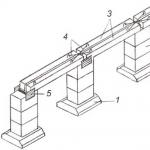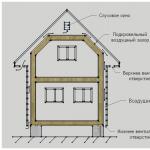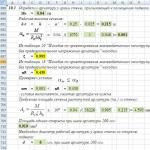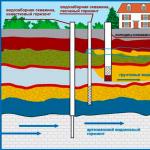Calculation of foundation depth calculator. Foundation price calculator. Types of foundations for a house
Then the cross-sectional area will be:
40 100 = 4000 cm2.
Determine the total cross-sectional area of the reinforcement (minimum):
4000: 1000 = 4 cm2.
Since the width of the tape is 40 cm, 2 rods need to be placed in one grid, and the total quantity is 4 pieces.
Then the minimum cross-sectional area of one rod will be 1 cm2. Using SNiP tables (or from other sources) we find the closest value. In this case, you can use reinforcing bars with a thickness of 12 mm.
Determine the number of longitudinal rods. Let's say the total length of the tape is 30 m (tape 6: 6 m with one jumper 6 m).
Then the number of working rods with a length of 6 m will be:
(30: 6) 4 = 20 pcs.
Determine the number of vertical rods. Let's say the pitch of the clamps is 50 cm.
Then, with a tape length of 30 m, you will need:
30: 0.5 = 60 pcs.
Determine the length of one clamp.
To do this, subtract 10 cm from the width and height of the section and add up the results:
(40 - 10) + (100 - 10) = 120 cm. The length of one clamp is 120 2 = 140 cm = 2.4 m.
Total length of vertical reinforcement:
2.4 60 = 144 m. The number of rods with a length of 6 m will be 144: 6 = 24 pcs.
NOTE!
The obtained values should be increased by 10-15% in order to have a margin in case of errors or unexpected material costs.

Types and sizes
There are two main :
- Metal.
- Composite.
The metal bars used to assemble the reinforcement cage have a ribbed or smooth surface.
Ribbed rods are used for horizontal (working) reinforcement, as they have an increased adhesion force to concrete, which is necessary to perform their functions efficiently.
Vertical rods, as a rule, are smooth, since their task is to maintain the working rods in the desired position until pouring. The diameter of the rods ranges from 5.5 to 80 mm. working rods of 10, 12 and 14 mm and smooth rods of 6-8 mm are used.
Composite reinforcement consists of different elements:
- Glass.
- Carbon.
- Basalt.
- Aramid.
- Polymer additives.
Fiberglass reinforcement is the most widely used.
It has the greatest strength, the most rigid and resistant to tensile loads of all other options.
Like all types of composite rods, fiberglass reinforcement is completely resistant to moisture.
Manufacturers claim constant performance throughout the entire service period, but in practice the validity of this statement has not yet been verified. The problem with composite reinforcement is the complexity of the technology, due to which the quality of the material differs markedly from different manufacturers.
In addition, composite rods are not able to bend, which is inconvenient when assembling frames and reduces the strength of the corner joints of the frame.
IMPORTANT!
Among builders, the attitude towards composite reinforcement is complex. Without denying the positive qualities, they do not put too much trust in little-studied building materials that have not gone through a full cycle of use. In addition, metal reinforcement has very specific technical characteristics, while composite types have a fairly wide range of properties. All these factors limit the use of composite rods.

How to make the right choice
The choice of reinforcing bars is based on design data and builder preferences.
Typically, metal rods are chosen, although composite reinforcement is increasingly used every year in the construction of strip foundations. Preference is given to metal rods due to the ability to give them the necessary bend, which is impossible to do with fiberglass rods.
This is especially important when constructing belts with curved sections or when there are fracture angles other than 90°.
In addition, metal reinforcement is more economical, as it allows you to make clamps from a single rod, without having to create multiple connection points.
The diameters of the rods have long been worked out in practice; they are often chosen without preliminary calculation - for about 30 cm, a 10 mm rod is used, for strips with a width of 40 cm, 12 mm rods are chosen, and for a width of more than 50 cm - 14 mm. The thickness of the vertical reinforcement is determined by the height of the tape; up to 70 cm, 6 mm is chosen, and for heights above 70 cm, 8 mm or more.


Useful video
In this section you can also see how calculations are performed using the example of a real construction site:
Conclusion
A well-chosen reinforcement scheme and the material itself ensure the strength and resistance of the tape to possible loads.
Complex and problematic soils, prone to heaving or seasonal movements, require a responsible and attentive approach to.
It must be taken into account that all calculated values determine the minimum design parameters that require some increase for a certain safety factor.
When choosing reinforcement and reinforcement scheme, you need to multiply all values by 1.2-1.3 (reliability factor) to reduce the risk of unforeseen factors.
In contact with
The foundation is the underground part of a building or structure that receives loads and transfers them to the ground. The most popular type of foundation for building houses is considered to be a strip foundation. This widespread use of strip foundations is explained by its versatility and affordable cost. Before you begin construction, you need to make a choice between a shallow and buried strip foundation.
Shallow strip foundation
A shallow foundation saves both budget and time. And labor costs will be significantly less, since its construction does not require a deep pit. The following foundation is used for lightweight structures of small area:
- wooden houses
- aerated concrete structures or buildings constructed from aerated concrete and foam concrete blocks, the height of which does not exceed 2 floors
- monolithic buildings with permanent formwork
- small structures built of stone
The depth of the shallow foundation reaches half a meter.
Recessed strip foundation
This foundation is used for the construction of structures with heavy walls, concrete floors, a basement or an underground garage. The length of the foundation depth must be calculated in advance. First, you need to determine the level of soil freezing, then subtract 30 cm and lay the foundation at this depth.
Preparing for work
To build a strip foundation yourself, you must first carry out precise planning. The need for careful calculations is explained by the fact that the foundation is one of the most important structural elements of any building or home. Mistakes made at the beginning of construction can provoke negative consequences during the operation of the house.
Marking
Marking is carried out by marking on the ground both the external and internal boundaries of the future foundation. To do this, it is best to use pegs or reinforcement rods and ropes. But it will be more effective to use special devices, such as laser levels. Remember that large errors in markings will noticeably affect the appearance of the finished building.

To achieve ideal results you need:
- determine the axis of the structure being built
- use a plumb line to mark an angle, then pull a rope from it at an angle of 90 degrees to two more corners of the structure
- use a square to determine another angle
- check the angles, focusing on the diagonals. If the test gives positive results, pull a rope between them
- take on the internal markings, retreating from the external markings to the distance of the thickness of the future foundation
When you are finished with the markings, study the differences in the surface at the construction site and select the lowest point to measure the depth of the trench and eliminate the difference in the height of the foundation. If the building is planned to be small, then the depth of the pit can be 40 cm.

Cushion installation and waterproofing of strip foundation
A sand cushion with added gravel should be laid on the finished trench. The recommended height of each layer is 120-150 mm. After this, each layer must be shed with water and compacted to increase density. To insulate the finished pillow, you need to lay out a durable waterproofing film on it.

Installation of strip foundation formwork
The formwork is usually made of planed boards approximately 40-50 mm thick. You can use slate for this purpose.
When erecting formwork, control verticality. The recommended height of the frame above the ground is 30 cm. This is necessary to build a small base. Asbestos concrete pipes are laid in the formwork to introduce sewerage and water supply into the building.

Place a plastic film between the concrete and the formwork; this will protect the formwork from contamination.
Laying reinforcement
The next stage is the installation of fittings. Reinforcing bars with a cross-section of 10-12 mm are connected with a special knitting wire so that the sides of the square cells are 30-40 cm. The reinforcement can be either steel or fiberglass.

Ventilation and communications
Pouring a strip foundation with concrete
Fill the formwork with concrete gradually. The thickness of the layers is 15-20 cm; to avoid voids and increase overall strength, compact the layers with a special tool - a wooden tamper or an internal vibrator.

You can order ready-mixed concrete from a factory or make it yourself using a concrete mixer. The recommended proportion of cement, sand and crushed stone is: 1:3:5.
The layers should not differ in composition. In cold weather, you should use a concrete heater and frost-resistant additives; in hot weather, water the concrete.
Completion of work
Once the concrete is poured, it should be covered with film to prevent drying out and left to gain strength for at least 2 weeks.

A strip foundation is a prefabricated or monolithic foundation made of high-strength reinforced concrete blocks, which are laid along the perimeter of the future structure, as well as in areas of load-bearing structures. The formation of a strip foundation does not involve the use of heavy construction equipment, but at the same time it requires absolute accuracy of calculation and measurement operations. The interactive strip foundation calculator will allow you to quickly and accurately calculate the proportion of sand, cement and crushed stone when making concrete manually, the dimensions of the strip, as well as the parameters of the formwork and foundation reinforcement for a house made of foam concrete or aerated concrete.
Advantages of the online strip foundation calculator
- Saves time, nerves, effort and money when drawing up cost estimates for the purchase of building materials.
- Allows you to estimate the volume of creative actions, as well as predict the timing of the formation of a strip-type foundation.
- Proper calculation of the parameters of reinforcement and concrete guarantees high strength and reliability of the internal frame of the structure.
- The ability to instantly calculate parameters for a monolithic or prefabricated, shallow or deeply laid strip foundation.
- 2D and 3D visualization options allow you to clearly assess the adequacy of calculation manipulations and make the necessary corrections in a timely manner.
Problems that the calculator solves
Calculation of reinforcement for a strip foundation helps determine the total length and weight of the reinforcement cage, as well as the minimum diameter of the transverse and longitudinal bars, the number of rows in the reinforcement chords, the spacing of the clamps and the amount of overlap. Calculations are made in accordance with the rules of SP 52-101-2003.
Calculation of concrete for a strip foundation provides information on the proportions of sand, crushed stone and cement, as well as the weight of the main building material for pouring the strip foundation. The calculation results make it possible to correctly and competently distribute the load across the structure segments.
The calculation of the formwork specifies the total length of the perimeter, as well as the area of the base and the outer side edge of the reinforced concrete strip.
An online calculator for calculating strip foundations works for you completely free of charge. If you have any questions, write below in the comments - we will definitely help you.
When constructing any building, it is important to correctly calculate the foundation. Calculate the foundation You can do this with the help of specialists or independently using a foundation calculator. Let's consider the most important points, this includes load calculation, the volume of the foundation pit and tips that need to be taken into account when creating a house foundation project. To calculate the foundation, you can use the foundation calculator.
1. Calculate the weight of the house structure.
An example of calculating the weight of a house structure: You want to build a house with a height of 1 floor, 5 m by 8 m, also an internal wall, the height of floor to ceiling is 3 meters.
Let's substitute the data and calculate the length of the walls: 5+8=13 meters, add the length of the inner wall: 13+5=18 meters. As a result, we get the length of all the walls, then we calculate the area, multiply the length by the height: S = 18 * 3 = 54 m.
We calculate basement floor area, multiply the length by the width: S=5*8=40 m. The attic floor will have the same area.
We calculate roof area, multiply the length of the sheet by the width, for example, a sheet of roofing has a length of 6 meters, and a width of 2 meters, as a result the area of one sheet will be 12 m, in total we will need 4 sheets on each side. In total, you will get 8 roofing sheets with an area of 12 m. The total area of the roofing will be 8 * 12 = 96 m.
2. Calculate the amount of concrete required for the foundation.
To begin the construction of a building, you need to draw up a project for the foundation of a private building, from which you can calculate the required amount of building materials for the construction of the structure. In our case, it is necessary to calculate the amount of concrete to create the foundation. The type of foundation and various parameters serve to calculate the amount of concrete.
3. Calculation of foundation area and weight.
The most important factor is the soil under the foundation; it may not withstand high loads. To avoid this, you need to calculate the total weight of the building, including the foundation.
An example of calculating the weight of a foundation: You want to build a brick building and have selected a strip foundation for it. The foundation goes deep into the ground below the freezing depth and will have a height of 2 meters.
Then we calculate the length of the entire tape, that is, the perimeter: P= (a+b)*2=(5+8)*2=26 m, add the length of the internal wall, 5 meters, and in the end we get the total length of the foundation 31 m.
Next we do volume calculation To do this, you need to multiply the width of the foundation by the length and height, let’s say the width is 50 cm, which means 0.5 cm * 31 m * 2 m = 31 m 2. Reinforced concrete has an area of 2400 kg/m3, now let’s find the weight of the foundation structure: 31m3*2400 kg/m=74 tons 400 kilograms.
The supporting area will be 3100*50=15500 cm2. Now we add the weight of the foundation to the weight of the building and divide it by the supporting area, now you have a load of kilograms per 1 cm 2.
Well, if, according to your calculations, the maximum load exceeded these types of soils, then we change the size of the foundation to increase its supporting area. If you have a strip foundation, then you can increase its supporting area by increasing the width, and if you have a columnar foundation, then increase the size of the column or their number. But remember, this will increase the total weight of the house, so it is recommended to re-calculate.
Activities for the construction of any building are preceded by design work, during which the type of foundation base and the required amount of materials for its construction are determined. An important part of the foundation is the reinforcement cage. It increases the strength of the base, dampens tensile forces and bending loads, and also prevents the formation of cracks. To carry out the work, you need to understand how much reinforcement is needed to reinforce a strip foundation, as well as for a columnar and slab foundation. Let's look at the features of the calculations.
Consumption of reinforcement for reinforcing strip foundations
We are preparing to calculate the amount of reinforcement for the foundation - important points
When planning the construction of a private house, you should pay special attention to the design of the reinforcement grid, which can withstand significant loads on the foundation. A qualified design of the load-bearing grid and the use of the optimal cross-section of the reinforcement makes it possible to ensure the required safety margin of the foundation base, as well as its long service life.
- using software and online calculators that perform reinforcement calculations after entering operating parameters;
- performing manual calculations based on information about the design features of the foundation, the magnitude of the forces and the lattice parameters.
The foundation takes the load from the mass of the building and evenly distributes it onto the supporting surface of the soil.
The construction of buildings is carried out on various types of foundations:
- tape;
- slab;
- columnar.
 Calculation of reinforcement for strip foundations
Calculation of reinforcement for strip foundations Before starting the calculations, you should understand the design of the power frame, which consists of the following elements:
- vertical and transverse rods, between which an equal interval is maintained;
- knitting wire connecting longitudinally located jumpers and vertical rods;
- couplings that provide a strong connection and elongation of reinforcing bars.
Each type of foundation has its own foundation reinforcement scheme, which depends on the following factors:
- soil characteristics;
- building dimensions;
- design features of the structure;
- current loads.
Reinforcement with a ribbed surface is used, which differs:
- section size;
- class;
- level of perceived loads;
- location in the power grid;
- cost.
 Laying reinforcement in a strip foundation
Laying reinforcement in a strip foundation For various foundations, the following information is determined based on calculations:
- amount of reinforcement for the foundation;
- assortment of vertical and transverse rods;
- total mass of the reinforcement frame;
- methods of fixing steel rods in a load-bearing structure;
- load-bearing lattice assembly technology;
- step of tying reinforcement elements.
It is important to perform the calculation correctly. In this case, the reinforcement for the foundation will provide the necessary margin of safety. Let's consider what initial data is needed for calculations, and also study the methodology for performing calculations for various types of foundations.
Calculation of the amount of reinforcement for a strip foundation
The strip-type base provides increased stability of buildings on various soils. The structure is a concrete strip that follows the contour of the building and is located under the main walls. Reinforcement with steel reinforcement increases the strength characteristics of the concrete base and has a positive effect on its durability. To construct a spatial lattice, you can use reinforcement with a diameter of 10 mm.
Initial data for performing calculations:
- length and width of the foundation base;
- section of reinforced concrete strip;
- spacing between frame elements;
- total number of strapping belts;
- size of the power grid cells.
 How much reinforcement is needed for a foundation?
How much reinforcement is needed for a foundation? Let's consider the order of calculations:
- Calculate the total length of the tape outline.
- Calculate the number of elements in the belts.
- Determine the footage of the horizontal bars.
- Calculate the need for vertical rods.
- Calculate the length of the crossbars.
- Add up the resulting footage.
Knowing the total number of joint sections, you can calculate the need for binding wire.
Calculation of the amount of reinforcement for a slab-type foundation
The foundation of a slab structure is used for the construction of residential buildings on heaving soils. To ensure strength characteristics, reinforcing bars with a diameter of 10–12 mm are used. With increased mass of buildings, the diameter of the rods should be increased to 1.4–1.6 cm.
- a spatial frame made of reinforcement is constructed in two levels;
- the connection of the rods is made in the form of square cells with a side of 15–20 cm;
- The binding is performed with annealed wire at each connection point.
 Scheme of reinforcement of a monolithic foundation slab
Scheme of reinforcement of a monolithic foundation slab To determine the need for reinforcement, perform the following operations:
- Determine the number of horizontal rods in each tier.
- Calculate the total footage of the reinforcing bars that form the cells.
- Add the total length of the vertical supports connecting the tiers.
Adding up the obtained values, we obtain the total need for reinforcement. Knowing the number of joints, it is easy to determine the required volume of steel wire.
How to calculate reinforcement for a columnar structure foundation
Columnar type foundation is widely used for the construction of various buildings. It consists of reinforced concrete supports of square and round cross-section, installed in the corners of the building, as well as at the intersection points of the main walls and internal partitions. To increase the strength of the supporting elements, ribbed rods with a cross section of 1–1.2 cm are used.
- the frame of the square profile support element is formed from 4 rods;
- the lattice of a reinforced concrete support with a circular cross-section is made of three rods;
- the length of the reinforcement elements corresponds to the dimensions of the supporting column;
- The transverse piping of the support column frame is carried out in increments of 0.4–0.5 m.
 Algorithm for calculating the consumption of foundation reinforcement
Algorithm for calculating the consumption of foundation reinforcement - Determine the length of the vertical bars in one support.
- Calculate the footage of the cross-bracing elements of one frame.
- Calculate the total length by adding the resulting values.
Multiplying the result by the number of supports, we get the total length of the reinforcement.
How to calculate reinforcement for a foundation - example calculations
As an example, let's consider how much reinforcement is needed for a 10x10 foundation formed in the form of a monolithic reinforced concrete strip.
To perform calculations we use the following information:
- base width 60 cm, allows you to lay 3 horizontal rods in each belt;
- 2 reinforcement belts are made, connected by vertical rods at intervals of 1 m.
- for a building 10x10 m and a base depth of 0.8 m, reinforcement with a diameter of 10 mm is used.
 Consumption of reinforcement for strip foundations
Consumption of reinforcement for strip foundations - We determine the perimeter of the building’s foundation by adding the length of the walls - (10+10)x2=40 m.
- We calculate the number of horizontal elements in one belt by multiplying the perimeter by the number of rods in one tier - 40x3 = 120 m.
- The total length of the longitudinal bars is determined by multiplying the resulting value by the number of tiers 120x2=240 m.
- We calculate the number of vertical elements installed 10 pairs on each side 10x2x4 = 80 pcs.
- The total length of the vertical rods will be 80x0.8=64 m.
- We determine the length of the jumpers, each measuring 0.6 m, installed on two belts (20 per side) - 10x2x4x0.6 = 48 m.
- Adding the length of the reinforcing bars, we get a total footage of 240+64+48=352 m.
Determining the length of steel wire is easy. The number of connections multiplied by the length of one piece of wire equal to 20–30 cm will give the desired result.
Let's summarize - how necessary is the calculation of reinforcement for the foundation?
When planning the construction of a house, bathhouse or country house, it is easy to determine the need for fittings with your own hands. Step-by-step instructions will allow you to use a calculator to calculate the footage of the rods for the manufacture of a reinforcing grid that strengthens the base of the building. Knowing how to calculate reinforcement, you can perform the calculations yourself without resorting to the help of third-party specialists. Correctly performed calculations will ensure the strength of the foundation, the stability of the building, as well as a long service life.






